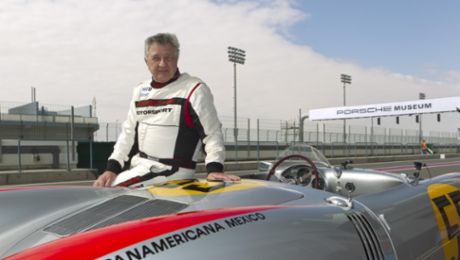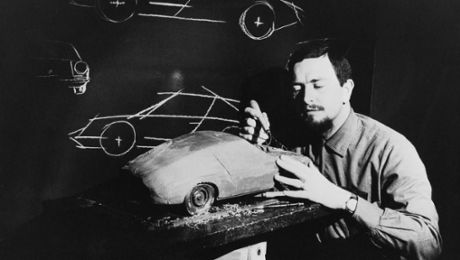While most of his friends of the same age were watching football, the 17-year-old Anthony-Robert ‘Tony’ Hatter was fascinated by the movie Le Mans starring Steve McQueen. The film would give him the lasting motivation to follow his dream and do everything possible to work as a designer at Porsche.
The sports car manufacturer was the subject of his technology degree. After his Master of Arts in Automotive Design at the Royal College of Art in London, Tony Hatter did not make it to Porsche immediately, instead taking a detour via Rüsselsheim. Five years later, in 1986, his dream became reality as he transferred from Opel to Porsche.
At Porsche, he valued the attitude of healthy competition between designers, which motivated him to perform at his best. Indeed, in 1988, he was allowed to affix three differently coloured rally stripes to a gold-coloured Porsche 959. When CAD was born into an era when modelling was still the prevalent method, Tony Hatter proved in the mid-1990s that he could not only design shapes, but also recreate them in a computer. Word of his talent in this area spread quickly, so in future he also took on orders for the racing departments. The modelling software offered a huge time advantage when validating the manual vehicle design. He was responsible as a designer for a long list of sports cars: 993, 993 Turbo, GT1 ’96, GT1 ’97, GT1 ’98, 996 II, 996 II GT3, 996 II GT2, 997 GT2 and the production model Carrera GT.
One of his most unforgettable projects for external clients during his time at Porsche was the design of the console for the Ladegast organ in St Nicholas Church in Leipzig.
A Turbo is just a step away from Le Mans for Tony Hatter. The gentle power of the 993 Turbo, just one of the vehicles for which he is responsible, captivated him in the 1990s just as it does today. In his dreams, the series production car takes to the grid at Le Mans – and thrills the crowd. Just like the cars in the movie of the same name, which inspired him to do everything he could to land his dream job at Porsche.
CV
| 13 December 1954 | Born in Newcastle, England |
| 1971 – 1972 | Tadcaster Grammar School |
| 1972 – 1974 | Harrogate College of Further Education / O.N.D. Technology |
| 1975 – 1979 | B.A. Transportation Design, Lanchester Polytechnic, Coventry |
| 1979 – 1981 | M.A. Automotive Design, Royal College of Art, London |
| 1981 – 1986 | Exterior Designer, Adam Opel, Rüsselsheim |
| 1986 – 2002 | Exterior Designer, Dr. Ing. h. c. F. Porsche AG, Stuttgart |
| 2002 – 2005 | Design Manager Customer and Special Projects |
| 2005 – 2014 | Design Manager Sports Cars |
| 2014 – 2020 | Head of Design Quality Style Porsche |
| since 2020 | Retired |



